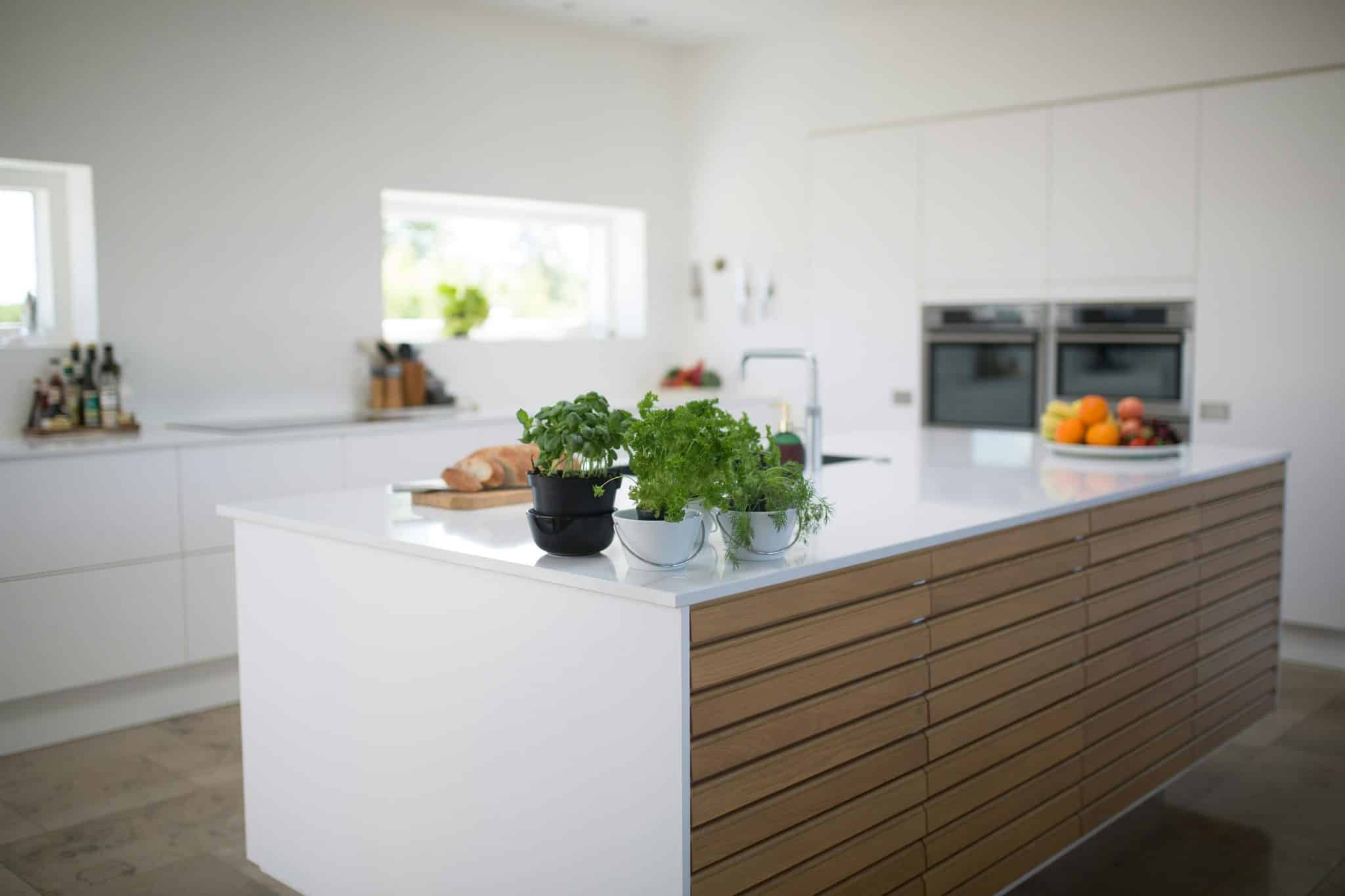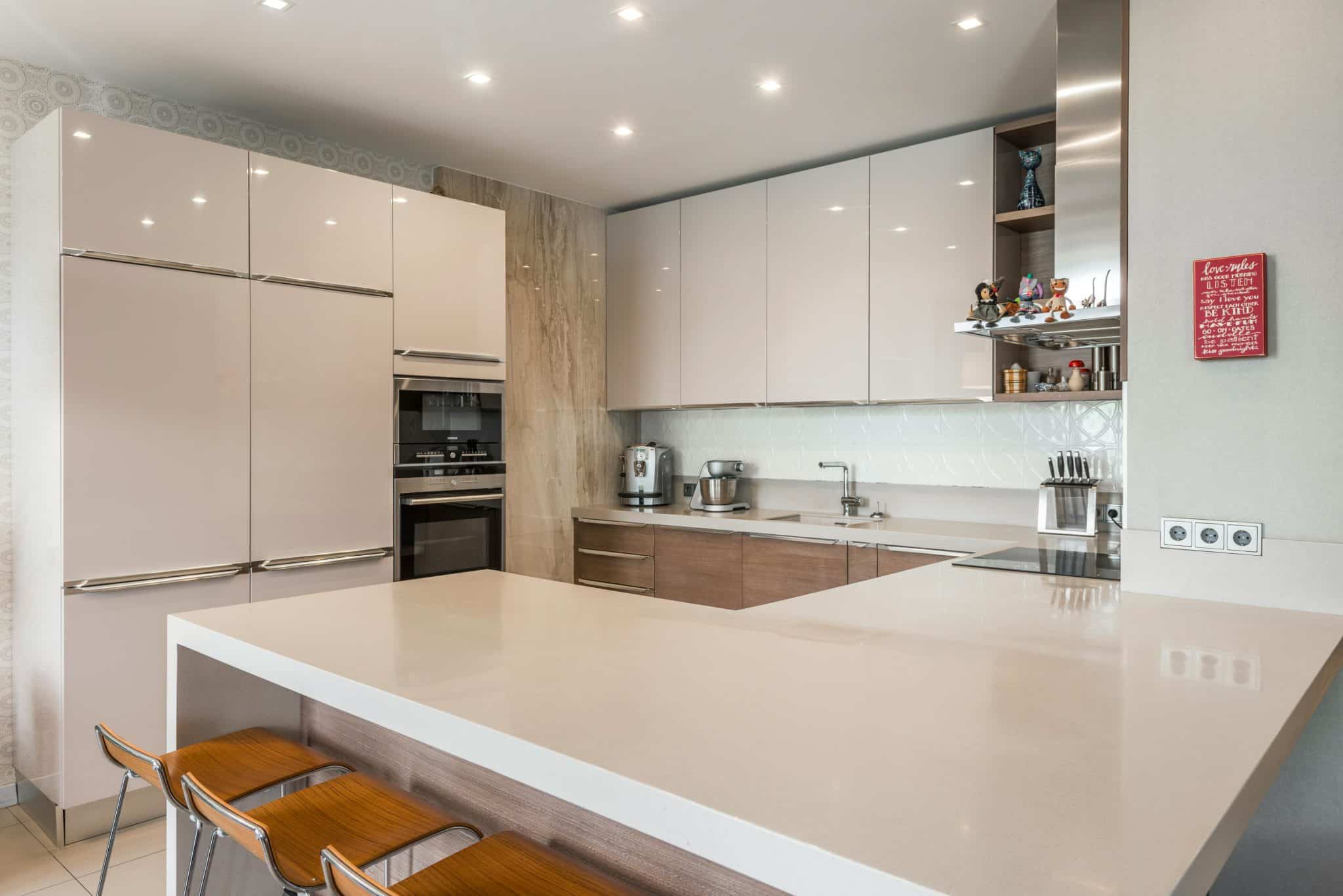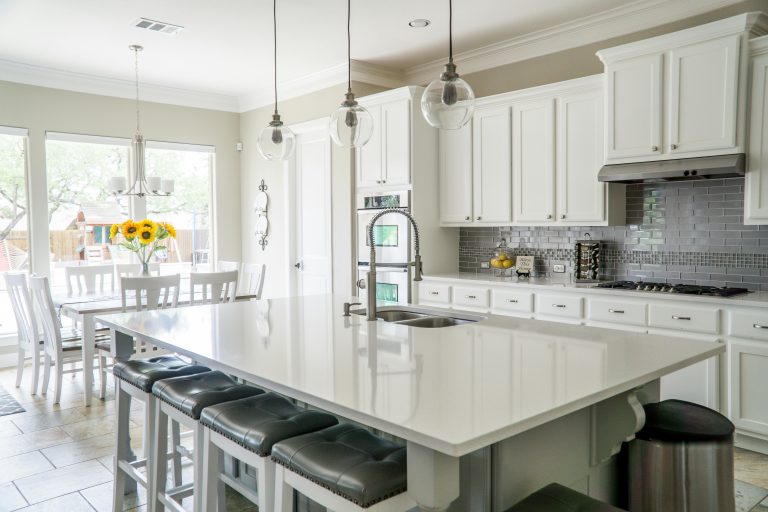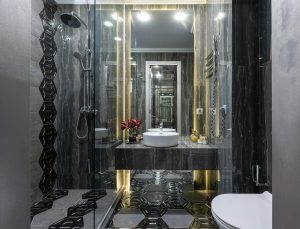A countertop is a structural component engineered to handle thermal stress, impact loads, and moisture exposure every single day. A well-designed countertop balances material performance, installation technique, and long-term maintenance to create a space that looks beautiful and endures years of use.
Below, we’ll break down technical considerations behind kitchen countertop selection, fabrication, and installation, the kind of knowledge that transforms a renovation project into a true engineering process.
Understanding Countertop Material Properties
Each countertop material has distinct mechanical and chemical properties that determine how it performs under real-world conditions. Key performance factors include compressive strength, thermal expansion, porosity, and scratch resistance.
Granite
- Composition: Natural igneous rock composed of quartz, feldspar, and mica.
- Strength: Excellent compressive strength (130–200 MPa) and superior heat resistance.
- Considerations: Varies in porosity and veining; proper sealing and support prevent stress cracks.
Quartz (Engineered Stone)
- Composition: Ground quartz with polymer resins and pigments.
- Strength: Uniform structure reduces natural defects and provides strong impact resistance.
- Considerations: The resin binder softens under extreme heat, so direct contact with hot cookware should be avoided.
Marble
- Composition: Metamorphic rock composed mainly of calcite.
- Strength: Softer than granite but highly aesthetic.
- Considerations: Prone to etching from acidic substances; requires frequent sealing.
Solid Surface
- Composition: Acrylic-based composite with alumina trihydrate filler.
- Strength: Moderate mechanical strength, flexible under stress.
- Considerations: Seamless joints are possible, but heat resistance is limited.
Butcher Block
- Composition: Laminated hardwoods bonded with waterproof adhesives.
- Strength: Varies by wood type; resilient to impact.
- Considerations: Requires regular oiling; reacts to humidity.
Porcelain / Sintered Stone
- Composition: Minerals fused under intense heat and pressure.
- Strength: Extremely dense, heatproof, and UV resistant.
- Considerations: Fabrication requires precision cutting tools to avoid chipping.
Structural Support and Substrate Engineering

Even the most durable materials can fail if not supported correctly. Countertops must rest on stable, level bases that distribute weight evenly and manage deflection.
Load Distribution
A 3 cm granite slab weighs roughly 18–20 lbs per square foot. Unsupported spans over 24 inches should include reinforcement, especially near sink and cooktop openings. Overhangs exceeding 12 inches require concealed steel brackets or corbels to prevent bending.
Substrate Leveling
Cabinetry must be level to within 1/16 inch across two feet. Laser leveling systems are commonly used to achieve the necessary precision. Thinner slabs (2 cm) often require plywood underlayment to ensure rigidity.
Thermal Expansion
Engineered materials expand slightly with temperature changes. Gaps of 1/8 inch along backsplashes or wall joints accommodate this movement and prevent edge cracking.
Fabrication and Installation
The difference between a flawless countertop and one that fails prematurely lies in the accuracy of fabrication and installation.
Digital Templating
Modern templating uses laser measurement systems that capture wall curvature and cabinetry irregularities. This data is converted into CAD files for CNC cutting ensuring sub-millimeter precision.
Edge Profiles
Edges are both functional and aesthetic. Rounded or eased profiles reduce chipping risk, while more complex designs require multiple polishing passes with progressively finer grits (typically from 50 to 3,000).
Seam Bonding
Two-part epoxy or polyester resin joins slabs with a joint width under 1/32 inch. Surface cleaning and correct resin ratios are essential to prevent weak, visible seams.
Cutouts and Reinforcement
Sink and cooktop cutouts weaken slabs. Reinforcing rods (fiberglass or steel) are epoxied beneath these areas to prevent cracking during installation and long-term use.
In the field, successful countertop installation depends as much on understanding materials as it does on experience with environmental conditions. Adam Hicks, founder and CEO of CooperBuild, a Miami construction company, emphasizes the importance of treating countertops like structural systems rather than decorative elements.
“Every countertop has its own mechanical behavior,” says Hicks. “In Miami, where humidity and temperature fluctuations are constant, we factor in moisture migration, substrate expansion, and sealant degradation over time. That’s what ensures stability and prevents failures two or three years down the line.”
Hicks points out that many installation failures originate from uneven cabinet alignment or lack of reinforcement beneath large spans. Careful load analysis and accurate templating eliminate these risks, ensuring a seamless integration between structure and surface.
Moisture and Vapor Management
Moisture control is critical to maintaining the integrity of countertop assemblies.
- Stone Materials: Require fluoropolymer-based penetrating sealers that block water absorption without altering vapor permeability.
- Wood: Needs breathable mineral oils that repel liquid but allow expansion and contraction.
- Underlayment: Vapor barriers installed above dishwashers protect undersides from delamination.
- Sealants: NSF-51 certified silicone sealants prevent mildew growth and joint discoloration.
Humidity is a constant variable in coastal environments, so professional installers often recommend hydrophobic sealants and routine inspections to ensure long-term performance.
Electrical and Mechanical Integration

Countertops often house built-in fixtures such as induction cooktops, pop-up outlets, or integrated sinks. Coordination between trades during the design and fabrication stage prevents interference and damage.
- Cutouts: Must maintain manufacturer-specified clearances for heat dissipation.
- Outlets: Pop-up or under-counter receptacles require precise pre-cut channels and moisture-proof housings.
- Sinks: Undermount sinks are dry-fitted before adhesive cure to maintain alignment.
- Ventilation: Downdraft appliances require precise routing for ducts through cabinetry voids.
Margaret Schaffer, founder of REH Interior, notes that functional design begins long before materials are selected.
“Every kitchen we design starts with technical planning,understanding appliance placement, outlet positioning, and ventilation,” she explains. “A countertop is an integrated system that supports workflow, comfort, and longevity.”
Her design approach emphasizes the collaboration between designers and builders to align mechanical systems with aesthetic intent, ensuring both function and form are balanced.
Maintenance and Material Longevity
A countertop’s lifespan depends heavily on correct maintenance practices. Understanding each material’s surface chemistry helps in selecting appropriate cleaning and sealing products.
|
Material |
Sealing Frequency |
Heat Resistance |
Scratch Resistance |
Cleaning Method |
|---|---|---|---|---|
|
Granite |
Every 12–18 months |
Excellent |
High |
Neutral pH cleaner |
|
Quartz |
None |
Moderate |
Very high |
Mild detergent |
|
Marble |
3–6 months |
Moderate |
Low |
Avoid acidic agents |
|
Solid Surface |
None |
Low |
Moderate |
Non-abrasive pad |
|
Wood |
Every 3 months |
Moderate |
Low |
Food-safe oil |
|
Porcelain |
None |
Excellent |
Very high |
Soft microfiber cloth |
Maintenance is about preserving material integrity. Consistent care ensures that joints, sealants, and surfaces maintain performance over decades.
Sustainability and Environmental Considerations
Sustainability is now a key factor in material selection and fabrication.
- Recycled Aggregates: Some quartz and solid surfaces use post-consumer materials.
- VOC Compliance: Low-VOC adhesives enhance indoor air quality.
- Water Management: Fabricators increasingly adopt closed-loop water recycling systems.
- Local Sourcing: Reduces transport emissions and supports regional suppliers.
Environmentally responsible fabrication not only benefits the planet but often improves material stability and long-term indoor air quality.
Conclusion
A kitchen countertop is a precisely engineered surface designed to balance load, resist moisture, and endure constant thermal stress. Selecting the right material is only half the equation; accurate installation, substrate preparation, and environmental awareness determine how long it will perform.
By understanding the material science and engineering behind countertops, homeowners and construction home builders can ensure that every project achieves both structural integrity and design excellence creating a kitchen that performs as beautifully as it looks.













